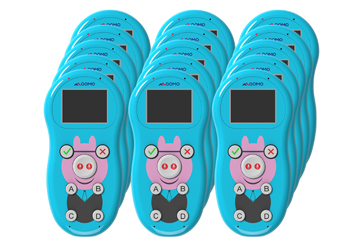
The new response systems offer tremendous value for students and provide an incredible amount of support for instructors. Professors not only can tailor when and how questions are posed in their lectures, but they can see who is responding, who is answering correctly and then track it all for future use or even as part of a grading system. It is a huge spike in involvement from students due to the interactive student keypads.
“You have proof of it, because the software archives this, and you can see which student responded and for how long they thought about a question,” Spors says. “It allows you to follow up and directly send an email to the students if you see something is not going right. It also flags a student’s participation through the interactive student voting system.
Spors says that from the software, instructors can get a weekly report that shows which students are achieving through their responses and which ones are struggling. It also can measure of the effectiveness of the instructor’s questions and “whether you have to go in and explain [a concept] again or not.”
Instructors can give credit for participation. They also can conduct 10-20 question exams through the ARS that are timed or untimed. The options are limitless. But the key, he says, is engagement, not necessarily scoring and grading.
“The overarching goal is to get the students engaged in the material, to talk about the material, to think about the material, and somehow get their feedback,” Spors says. “That is ultimately what they need to do in order to learn. If there is a participation reward, the students are much more likely to bring in the answer, even though they might not be very sure about it. As instructors, this gives us much better feedback on how well certain topics are understood.”
Working the ARS
Spors says the ARS is especially effective in science-based education environments and others where more dynamic two-way dialogue can occur. In his courses, which require teaching a lot of optics concepts and materials, he says it is helpful to be able to elicit real-time responses.
“There’s a lot of didactic material to talk about, a lot of problem-solving going on, that lends itself very well to be in an audience response system,” he says.
Not every lab or lecture is a good fit for ARS. He says high-level clinical education conducted in small groups, where students must comb through a lot of information, likely won’t mesh with a quick question-and-response system. He admits ARS is very valuable but is only one part of a success teaching strategy.
“Technology is only as good as it’s utilized,” Spors says. “It could be done clumsily. It could be completely overdone. It could be done in a way that the students get frustrated. So you have to be careful. You have to know the system. You have to know its limitations. And you don’t want to overdo it. It has to be the right amount.”
But if it’s done right, the benefits far outweigh the drawbacks.
“The system makes a difference in how the students received the material, how they feel about it,” Spors says of his students. “We did get improvement from the prior year when they participated. It’s just one tool, but it’s a pretty useful tool.”
Media Contact
Company Name: Qomo (Fuzhou) Electronic Technology Co., Ltd.
Email: Send Email
Phone: 0086 15280023723
Country: China
Website: https://www.qomo-odm.com/
